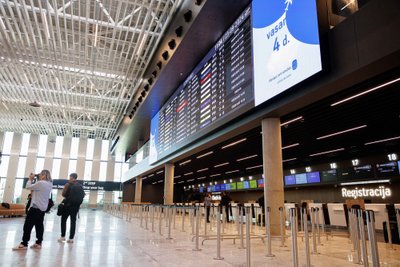"These are the years when we take strategic steps to further improve service quality, digitise certain processes, and strengthen the contribution of the country’s airports to the economy. The list of major projects shows that while some works are finishing, others are just beginning. This is crucial because, as infrastructure changes continue, airports operate as usual without disruptions, allowing us to maintain our momentum and grow competitiveness in the region," said LTOU CEO Simonas Bartkus.
Counting Down to the New Terminal’s Launch
Bartkus pointed out that the beginning of this year will culminate with the opening of the new Vilnius Airport departures terminal. Final testing and other processes are currently underway. Once the terminal begins operations in February, Vilnius Airport’s total area will increase by one-third (14,400 sq. meters), and its passenger capacity will double – from 1,200 to 2,400 passengers per hour.
The departure terminal project has focused not only on passenger comfort and fast service but also on sustainability. The new building will meet A++ energy efficiency standards and hold the international BREEAM certification. Its sustainable construction will lead to improved operational parameters. The 5,000 sq. meters of solar panels on the building’s roof will generate energy to meet about one-third of the terminal’s electricity needs.
In preparation for the new start, a new transportation flow and parking scheme at Vilnius Airport was implemented at the end of last year, making it possible to more efficiently serve car and public transport traffic.

Changes to the Old Terminals in Vilnius
This year, work will also begin on the conversion project of existing spaces at Vilnius Airport. The redevelopment of two terminals, originally built in 1993 and 2007, is expected to be completed in about a year and a half – from mid-2025 to the end of 2026. During this time, Vilnius Airport will operate as usual.
"The layout of the old terminals can no longer support successful airport growth, so the spaces will be redesigned and transformed. This will allow for significant expansion of commercial activities and provide passengers with more options for diverse and higher-quality services," Bartkus said. The conversion will cover approximately 10,000 sq. meters, with changes affecting everything from floors to the roof.
A contractor for the terminal conversion is currently being sought, with a public procurement process underway. The project aims to integrate more advanced technologies into daily operations at Vilnius Airport and improve the energy efficiency of the old buildings. The terminals being renovated (T2 and T3) currently feature a common departure hall, baggage checks, aviation security areas, arrival and departure gates, and commercial spaces.
Preparing for the Construction of a New Arrival Terminal
A competition for an architectural concept for the new Vilnius Airport arrival terminal is currently ongoing. Architects can submit final proposals by the end of March 2025.
The goal of the architectural competition is to design a modern, efficient arrival terminal that will enable the airport to integrate with the future Rail Baltica connection, the newly built departure terminal, and the reconstructed central square. The new arrival terminal must also accommodate increasing passenger traffic and improve the passenger experience, as well as support modern airport technologies.

Expanding Kaunas Airport’s Capacity
The experience gained from completing the Vilnius Airport departure terminal ahead of schedule has proven valuable, allowing the company to refine its large-scale project management practices. These lessons have been successfully applied to the Kaunas Airport passenger terminal expansion project, which will be completed by the beginning of fall 2025.
The expanded Kaunas Airport terminal will be able to serve twice as many passengers – about 2 million per year. The arrival and departure spaces will be enlarged, technological advancements will be implemented, speeding up procedures and improving the passenger experience. The total terminal area will increase by about 4,400 sq. meters, enabling the airport to handle up to six passenger flights per hour, compared to the current capacity of four.
Along with terminal construction, an important project – the expansion of the northern apron – has been underway since early 2024 at Kaunas Airport. This project is expected to be completed by spring 2025, increasing the number of aircraft parking spaces by more than one and a half times. New aircraft parking and engine testing areas will be created. This project will open up opportunities to expand aircraft maintenance services at Kaunas Airport, which is a key aircraft repair and maintenance hub in the Baltic region. It will also create conditions to increase cargo transport volumes, as Kaunas Airport plays a strategic role in NATO logistics.
Expanding the Use of Risk-Sharing Models
Bartkus noted that the past year was also significant for the promotion of new routes. Contracts based on the risk-sharing model have opened up more strategically important routes for the country to the West, strengthening Lithuania’s ties with its economic, defence, and political partners. The risk-sharing model was first implemented in 2023, connecting Vilnius with London City Airport through direct flights operated by LOT Polish Airlines. In 2024, a contract with Latvian carrier Air Baltic created new routes from Vilnius to Lisbon, Düsseldorf, and Hamburg.
"We are currently analysing the situation in the aviation market, airline positions, and plans, which reflect opportunities and partnership potential. We are committed to continuing the development of this model, as it is the best way to promote strategically important routes for Lithuania," said Bartkus.
According to the LTOU CEO, new regular flight routes from Vilnius to Prague (Czech Republic) and Tirana (Albania) are planned for this year, as well as charter flights from Palanga to Turkey and Egypt.
